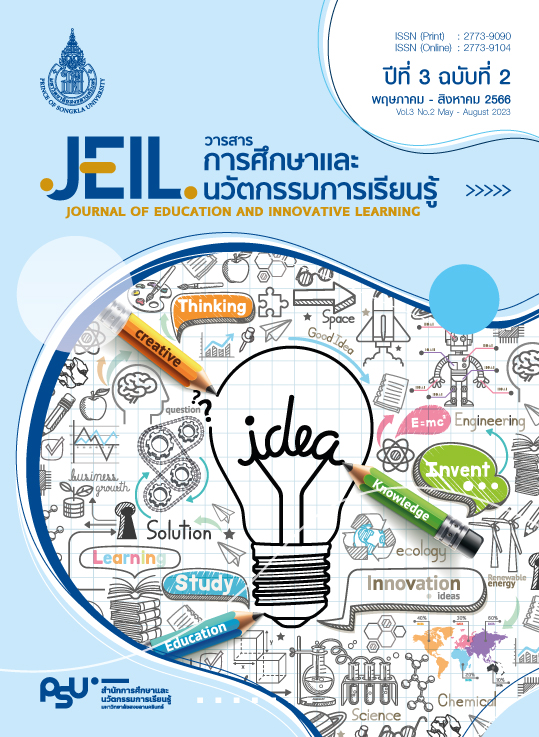การพัฒนาทักษะการแก้ปัญหาแบบร่วมมือของนักเรียนชั้นมัธยมศึกษาปีที่ 5 โดยใช้การจัดการเรียนรู้นวัตกรรมเลียนแบบธรรมชาติตามแนวสะเต็มศึกษา
Main Article Content
บทคัดย่อ
ทักษะการแก้ปัญหาแบบร่วมมือ เป็นหนึ่งในทักษะสำคัญในศตวรรษที่ 21 ที่ช่วยให้มนุษย์สามารถทำงานและแก้ปัญหาที่ซับซ้อนได้อย่างมีประสิทธิภาพ อย่างไรก็ตามยังพบการศึกษาในประเด็นดังกล่าวน้อยสำหรับการเรียนในห้องวิทยาศาสตร์ งานวิจัยชิ้นนี้มีวัตถุประสงค์เพื่อพัฒนาระดับ CPS ที่ผ่านการจัดการเรียนรู้นวัตกรรมเลียนแบบธรรมชาติ ตามแนวสะเต็ม โดยใช้รูปแบบการสอนแบบ Biomimicry Design Spiral กลุ่มที่ศึกษาคือนักเรียนชั้นมัธยมศึกษาปีที่ 5 เก็บรวบรวมข้อมูลโดยจากแบบวัด CPS แบบสังเกตพฤติกรรม อนุทินสะท้อนความคิดของครูและนักเรียน จากผลการวิจัยพบว่าระดับ CPS ของนักเรียนระดับมีแนวโน้มที่สูงขึ้น โดยเฉพาะในองค์ประกอบย่อยการติดตามและปรับแก้ความเข้าใจที่มีร่วมกัน (D1) ซึ่งผู้วิจัยพบว่าแนวปฏิบัติที่ดีในการจัดการเรียนรู้นวัตกรรมเลียนแบบธรรมชาติ มีลักษณะสำคัญดังนี้ 1) การกำหนดสถานการณ์ปัญหาที่ซับซ้อนพร้อมกำหนดขอบเขตที่ชัดเจนจะช่วยกระตุ้นให้นักเรียนสามารถวางแผนการดำเนินงานและรับรู้ความสามารถของสมาชิกกลุ่มได้ดี 2) การนำเสนอตัวอย่างนวัตกรรมที่นำแรงบันดาลใจจากธรรมชาติสามารถช่วยขยายมุมมองในการการระบุและอธิบายภาระงานที่ต้องทำให้สำเร็จได้มากขึ้น และ 3) การตั้งคำถามกระตุ้นและการใช้กิจกรรมสะท้อนคิดร่วมกันภายในห้องช่วยส่งเสริมกระบวนการติดตามและสะท้อนความเห็นของนักเรียน
Article Details

อนุญาตภายใต้เงื่อนไข Creative Commons Attribution-NonCommercial-NoDerivatives 4.0 International License.
เนื้อหาและข้อมูลในบทความที่ตีพิมพ์ในวารสารการศึกษาและนวัตกรรมการเรียนรู้ ถือเป็นข้อคิดเห็นและความรับผิดชอบของผู้เขียน ซึ่งกองบรรณาธิการวารสาร ไม่จำเป็นต้องเห็นด้วยหรือร่วมรับผิดชอบใด ๆ และไม่สงวนสิทธิ์การคัดลอกบทความเพื่อใช้ประโยชน์ทางวิชาการ แต่ให้อ้างอิงข้อมูลแสดงที่มาของบทความทุกครั้งที่นำไปใช้ประโยชน์
เอกสารอ้างอิง
Achakunwisut, E. (2014). Assessing collaborative problem solving of PISA 2015. IPST Magazine, 43(191), 37-41. [in Thai]
Antonenko, P. D., Jahanzad, F., & Greenwood, C. (2014). Fostering collaborative problem solving and 21st century skills using the DEEPER scaffolding framework. Journal of College Science Teaching, 43(6), 79-88.
Aufschnaiter, C. V., Erduran, S., Osborne, J., & Simon, S. (2008). Arguing to learn and learning to argue: case studies of how students’ argumentation relates to their scientific knowledge. Journal of Research in Science Teaching, 45(1), 101-131. doi:10.1002/tea.20213
Care, E., & Griffin, P. (2014). An approach to assessment of collaborative problem solving. Research and Practice in Technology Enhanced Learning, 9(3), 367-388.
Chang, C. J., Chang, M. H., Chiu, B. C., Liu, C. C., Chiang, S. H. F., & Wen, C. T., ... Chen, W. (2017). An analysis of student collaborative problem solving activities mediated by collaborative simulations. Computers & Education, 114, 222-235. doi:10.1016/j.compedu.2017.07.008
Cholsin, J., Kijkuakul, S., & Chaiyasith, W. C. (2018). The action research for developing learning management on stoichiometry based on STEM approach emphasized engineering design process to promote collaborative problem-solving competency. Journal of Education Naresuan University, 20(2), 32-46. [in Thai]
Foltz, P. W., & Martin, M. J. (2008). Automated communication analysis of teams. In E. Salas, G. F. Goodwin, & C. Shawn Burke (Eds.), Team effectiveness in complex organizations (445-466). New York: Routledge.
International Technology Educator Association. (2009). The overlooked STEM imperatives: Technology and engineering k-12 education. Reston: Author.
Kemmis, S., McTaggart, R., & Nixon, R. (2014). The action research planner: Doing critical participatory action research (3rd ed.). Victoria: Deakin University.
Kim, M., & Tan, H. T. (2013). A collaborative problem-solving process through environmental field studies. International Journal of Science Education, 35(3), 357-387. doi:10.1080/09500693.2012.752116
Organization for Economic Co-operation and Development. (2013). PISA 2015 Draft Collaborative Problem Solving Framework. Paris: OECD.
Organization for Economic Co-operation and Development. (2017). PISA 2015 Results (Volume V): Collaborative Problem Solving. Paris: OECD. doi:10.1787/9789264285521-en
Riechert, S. E., & Post, B. K. (2010). From skeletons to bridges & other STEM enrichment exercises for high school biology. The American Biology Teacher, 72(1), 20-22. doi:10.1525/abt.2010.72.1.6
Sottilare, R. A., Shawn Burke, C., Salas, E., Sinatra, A. M., Johnston, J. H., & Gilbert, S. B. (2018). Designing adaptive instruction for teams: A meta-analysis. International Journal of Artificial Intelligence in Education, 28(2), 225-264. doi:10.1007/s40593-017-0146-z
Swiegers, G. F. (2012). Bioinspiration and biomimicry in chemistry: reverse-engineering nature. New Jersey: John Wiley & Sons.
Taub, R., Armoni, M., Bagno, E., & Ben-Ari, M. M. (2015). The effect of computer science on physics learning in a computational science environment. Computers & Education, 87, 10-23. doi:10.1016/j.compedu.2015.03.013
Tayom, C., Kijkuakul, S., & Klamtet, J. (2017). Action research for developing collaborative problem-solving competency by using DEEPER scaffolding framework on stoichiometry topic for enrichment science classroom, Mathayom Suksa IV students. Academic Service Journal Prince of Songkla University, 28(2), 34-45. [in Thai]
Teerada, C., Skonchai, C., & Wipharat, C. (2017). Development of Collaborative Problem Solving Competency Using Research-Based Learning According to STEM Education inFossil Fuels and Products. J. Res. Unit Sci. Technol. Environ. Learning, 8(1), 51-66. [in Thai]
The Biomimicry Institute. (n.d.). What is Biomimicry?. Retrieved from https://biomimicry.org/what-is-biomimicry.
The Institute for the Promotion of Teaching Science and Technology. (2018). Collaborative Problem-Solving: How to Measure in PISA?. Retrieved from https://pisathailand.ipst.ac.th/issue-2018-25 [in Thai]
Thongchai, A. (2012). Summary of special lectures on the Issue of Science, Technology, Engineering, and Mathematics Education: Preparing students for the 21st Century. Retrieved from https://designtechnology.ipst.ac.th/wp-content/uploads/sites/83/2017/09/STEMeducation.pdf [in Thai]
Vasquez, J. A., Sneider, C. I., & Comer, M. W. (2013). STEM Lesson Essential: Grades 3-8: Integrating science, technology, engineering, and mathematics. Portsmouth, NH: Heinemann.
Zollman, A. (2012). Is STEM misspelled?. School Science and Mathematics, 111(5), 197-199.


